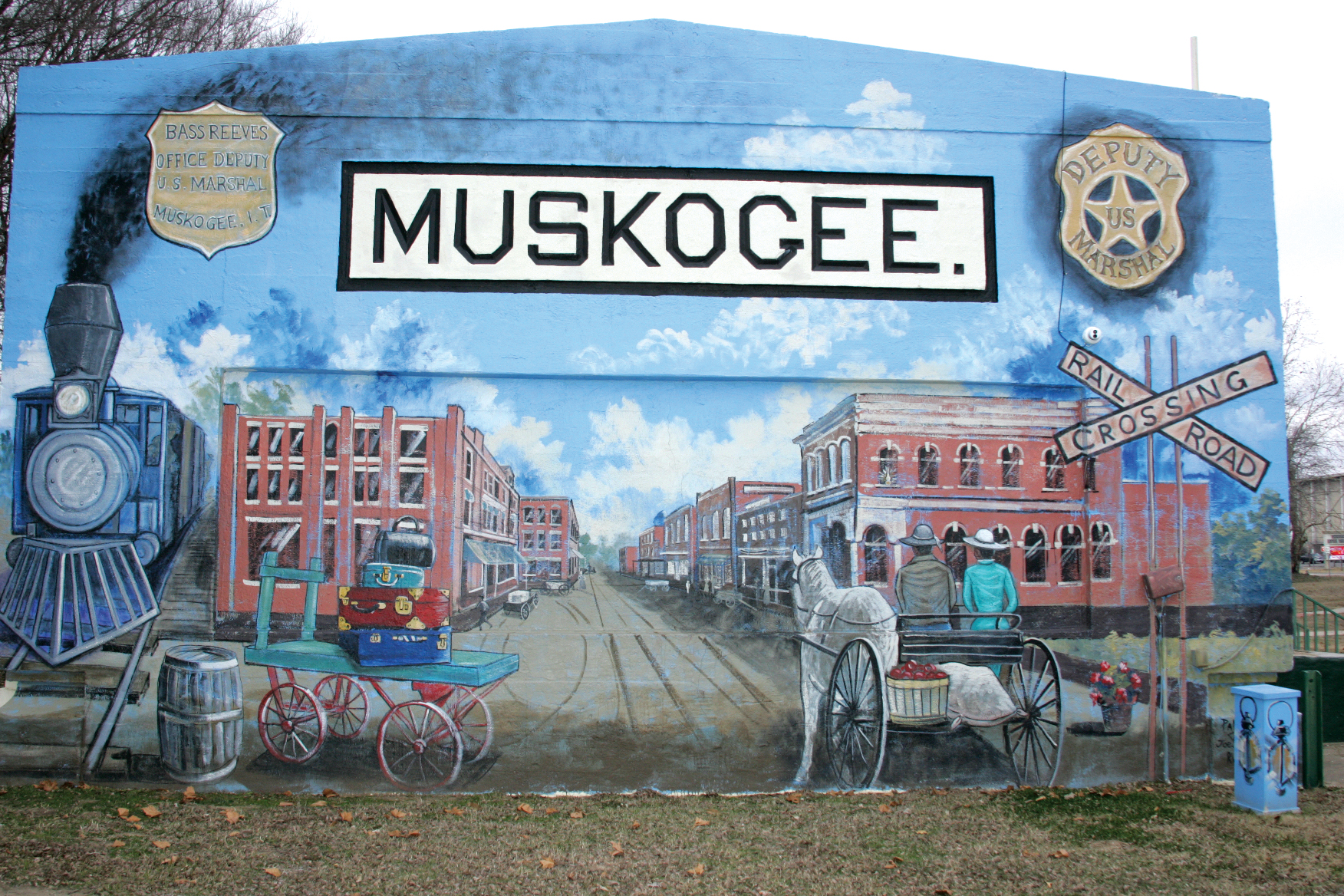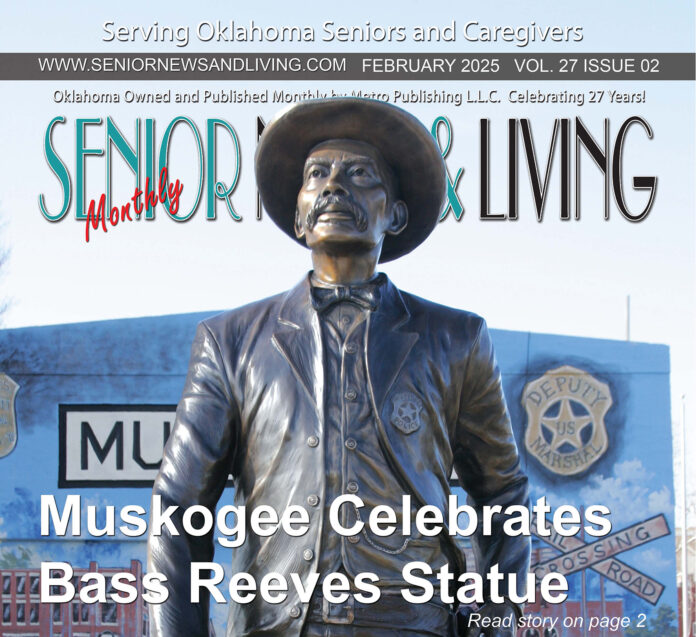story and photo by Darl DeVault, contributing editor

Last month, Muskogee, Oklahoma, community leaders proudly unveiled a remarkably lifelike, heroic-sized bronze statue of Bass Reeves, honoring his significant role in both the town’s and Oklahoma’s history as America’s most celebrated Black peace officer. This initiative to promote inclusivity and diversity comes at an ideal time to emphasize the beginning of Black History Month in February.
It is a testament to Oklahoma’s artistic talent and community spirit that the two statues of Deputy U.S. Marshall Reeves, destined to become the most revered images of the great lawman, were sculpted by Oklahomans.
The first statue of Reeves sculpted on horseback by the late nationally preeminent equestrian sculptor Harold Holden from Enid, Oklahoma, has stood in Fort Smith, Arkansas, since 2012. Sent by U.S. Circuit Judge Iassac Parker, Reeves rode from there into Indian Territory for 32 years to arrest outlaws as the first Black deputy U.S. marshal west of the Mississippi.
And now, the new image of the famous 6-foot-2 lawman marks the end of his groundbreaking journey from slavery to respected Muskogee police officer. It graces an area near where he walked patrol for the last two years of his life at 71. On the Three River Museum grounds, the bronze statue by acclaimed Oklahoma artist Joel Randell from Luther, Oklahoma, has a large mural backdrop at the end of the building.
The eight-foot-tall bronze statue of Reeves is depicted striding on patrol in front of a large mural recreating the Muskogee street scene from his era.
“I hope people will come here and be inspired by his dedication, hard work, and never-give-up attitude despite the overwhelming circumstances of his birth into slavery and how he overcame that,” sculptor Randell said.
This depiction now joins those iconic images promoting achievements by Black Americans and other people of African descent. Born into slavery in 1838 in Arkansas, Reeves died in 1910, almost half a century after the 13th Amendment abolished slavery in America. The 13th Amendment, ratified in 1865, was a significant milestone in the fight for civil rights and equality in the United States.
Considered the most famous Black law enforcement officer in American history, these two statues by master sculptors provide fitting bookends in depicting his exemplary career. By honoring Reeves in this way, Muskogee townspeople have given America a place where people can come to celebrate Blacks’ contributions to our country.
“He was ignored because he was black, and people of color were marginalized for years and years, and so it’s a point of pride for us here in Muskogee to acknowledge this man who overcame a lot, ” Muskogee author Jonita Mullins said at the unveiling.
For Reeves, it was not about gunplay, although he was a crack shot and killed 14 men while discharging his duties of arresting 3,000 criminals. He tried to manage the outcome of his interaction with desperados using ingenuity and originality. He often displayed a superior intellect by expending extra energy in employing guile and trickery and sometimes acting to approach the outlaws close enough to disarm them safely. This trademark mindset allowed him to safely discharge his purpose and function at a time when many deputies were killed in the line of duty.
Former University of Central Oklahoma art professor Bob Palmer,73, and Randell, 50, meticulously researched historical photos to paint a street scene mural on the end of the Three Rivers Museum (the restored Midland Valley Railroad Depot). The museum has created large displays about Reeves inside the renovated railroad depot in Muskogee’s Depot District. The new mural and statue are intended to further highlight the depth of this project by adding more to Muskogee’s rich, multi-cultural local history.
“By Joel and I painting the mural as a backdrop together and Joel sculpting the statue separately, we were able to bring Reeves and his surroundings back to life in a unique way, honoring his last two years in Muskogee,” Palmer explained.
This personal dedication to the project is a testament to the artists’ admiration for Reeves and their commitment to honoring his legacy.
Living in Bethany, Oklahoma, Palmer’s extensive experience in mural painting is evident in his impressive portfolio of over 3,500 murals across the state, making him the most-viewed artist in Oklahoma. His dedication to public art is demonstrated in his 30-year collaborations with former UCO art students, like Randell, in his mural painting business.
“Our goal was to help viewers mentally transport themselves back to when Mr. Reeves was chasing outlaws in Indian Territory and walking a beat in Muskogee,” Palmer said. “This goal underscores the intention behind the artwork, aiming to provide a unique experience for the viewers. We are proud to help the civic leaders in Muskogee provide America with a location to honor the numerous contributions Black individuals have made to our country.”
Positioned outdoors, with the midday sun casting light on the right side of the eight-foot statue, the shifting light in the round adds an interactive dimension to Reeves’ statue. This added experience matches the masterful craftsmanship demonstrated in Randell’s sculpting and the fidelity of the foundry in casting it just as he envisioned it.
“The fine art foundry, Bronze Services of Loveland in Colorado, did an outstanding job casting it in bronze. Their highly experienced artisans went above and beyond to capture my vision,” Randell said.
Photography highlights this effect, as capturing the same image from the front using a flash alters the shadows. This alteration contributes a vibrant, dynamic quality to the master sculptor’s work.
Photographers reviewing their captured images later realize they documented two distinctly different representations presented to the audience: one under natural light and another under illumination from flash photography.
“The final work of applying the patina to the bronze surface was carried out with the precision craftsmanship that this type of project demands,” Randell said. “The depth of muted subtleties of coloration I asked for in applying the patina was spectacular, especially the rich brown for Reeves’ holster as I intended it to look.”
This distinction of depth is further enhanced by the clear coat applied to the sculpture after the patina treatment, aiming to increase its durability against the elements in the future.
The overall impact of these measures results in Reeves having an inner glow that should ensure it remains a favorite among viewers for years to come.
“Another special enhancement to this monument was the great devotion to its presentation for the ages when owner Asa Nelson of Nelson Monument Company in Guthrie went to great lengths to get us a beautiful looking Dakota Mahogany granite base with Bass Reeves engraved on the front,” Randell said. “He led his highly experienced team of Dave Henson and Blake Finley to deliver the granite and the bronze sculpture that came in a shipping crate from Loveland and installed both onsite on the museum’s east side. Asa was ecstatic about being a part of the effort to honor Reeves, and it showed in how meticulous he was installing it just as I asked.”
The Three Rivers Museum has a Bass Reeves Western History Conference each year, with the next being June 26-28th, 2025















